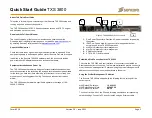
3
Main transformer
Instruction manual
IM1002004E September 2015 www.powerquality.eaton.com
Main transformer
●
●
Windings: all copper
●
●
Magnetics: grain orientated, M6 grade, stress-relieved
transformer steel is utilized for minimum losses and
maximum efficiency
●
●
Insulation: Class (N) 200 all sizes
●
●
Shielding: multiple triple copper shield to minimize
interwinding capacitance, transient, and noise coupling
between primary and secondary windings
●
●
Cooling: convection, operating temp is 130 degrees
Celsius maximum rise above ambient
●
●
Isolation: output is fully isolated from input
Cabinet
Heavy-gauge industrial steel throughout. Metal is
anti-corrosive phosphate treated prior to paint. Paint
is a baked finish.
Input breaker
Main input molded-case circuit breaker, rated at 125% of full
load input current.
Industry standards
Listed to UL 1012, standard for “power units other than
Class 2.”
Theory of operation
The Power-Sure 700 provides the triple function of isolation,
noise attenuation and voltage regulation. The first two
functions are provided by the power transformer, where as
the third function of voltage regulation is achieved through
solid-state thyristors (SCRs) connected to taps on the power
transformer. A microprocessor monitors and controls the
overall function of regulating the system.
The power transformer is manufactured with a unique
method of shielding which produces very low capacitive
coupling between the primary and secondary. This low
coupling provides excellent attenuation of the common-
mode noise. In addition, special care is taken in the design
of the transformer to attenuate transverse-mode noise
above 1000 Hz.
The power transformer has taps to which solid-state
switches (SCRs) are connected.
The voltage regulator incorporated in the Power-Sure 700
is microprocessor controlled to achieve optimum correction
time of input voltage sags and surges. The response time is
typically one half (1/2) cycle for 100% correction, therefore,
a very smooth switch takes place undetected by computer
equipment.
As the input voltage (building power) varies, the voltage
available at each tap of the transformer will also change.
The amount of variation is dependent upon the input sag
or surge, turns ratio, and transformer losses.
By selecting a particular tap voltage, the output can be kept
within a tight range. The way in which this is accomplished
is that an electronic control card using a microprocessor
continually monitors the input voltage. When a voltage
fluctuation occurs, which exceeds the limit of rated regulation
(typically ±3%), the output is switched to another tap, that
is within the required range. This “switch” will be made at
the next current zero crossing to allow for both leading and
lagging power loads to be connected to the conditioner.








































